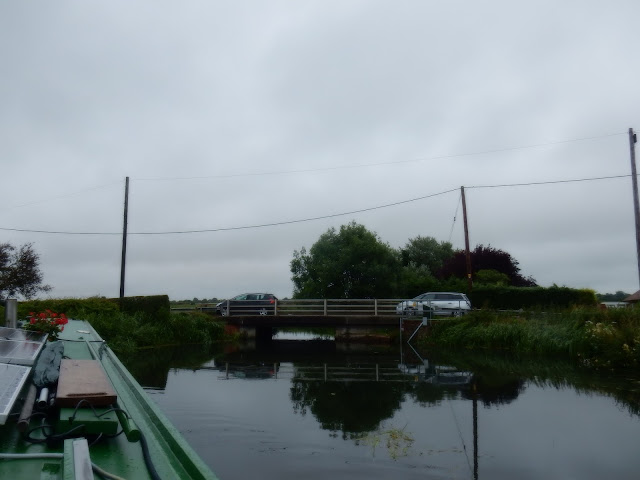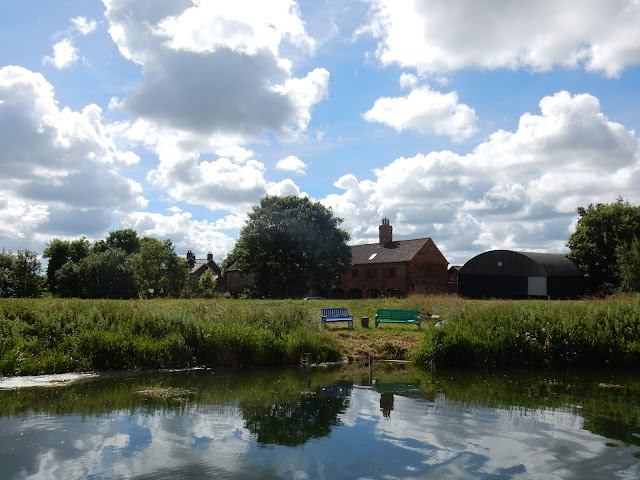On Wednesday the weather was not very good at all. There were high winds and continuous rain. However about 1000 the intrepid members of the Driffield Navigation Trust turned up with a crane and trailers to carry out their promise to lift out any boats that wanted to attend the Driffield Navigation 250th Anniversary event at Driffield Basin but were stymied by the fixed bridges. It took me a while to convince them that their crane would not be able to lift our boat out even if I was going to attend!
As it was one boat, 'Rose of Yorkshire' had braved the elements to arrive at North Frodingham Wharf the night before. We moved down to the end of the quay to be out of the way. The bank that had been put in to prevent seepage through the wharf, that can be seen to the left of the line of stone in from the water, was needed by the Environment Agency made it a little difficult for the crane to set up.
Up and over; the 'Rose of Yorkshire' rose out of the water and onto the trailer. The bales were perfect for resting the hull on and protecting it to.
The only other boat to be lifted out was a 'trip' boat of the Trust that was going to be carrying passengers over the weekend. It was an ex Marines/Army craft with the fantastic timber framed greenhouse fitted.. They were telling me about an anniversary cruise that was coming up with candle and flowers, champagne etc. I thought what a great night cruise that could be had with all that glass, a slow pootle along with a candle and a wine and just stare out at the stars.
Our plans for a good walk in the lovely country came to naught as it never stopped raining all day. We did venture into the village for 'Pie and Pint' night at the local, The Blue Post. It was good home cooking and was a real bargain. Later we were joined by some friends and whiled away the night.
Next day the rain had stopped and the 40mph winds had fallen away. Unfortunately there was not a glimmer of sun to be had. We were off back to Beverley and it was time to leave the wharf that was built in 1826. Just the other side of the bridge above the Frodingham Beck splits into the Keld Beck and the Old Howe. For us there is a spot big enough for us to wind, otherwise it would be 3/4 mile, with many bends, back to the junction.
Whilst being at the wharf we had watched a barn owl hunting and sitting by the barn in the farm opposite. Yesterday was a wash out for it so it was out in broad daylight hunting now the rain had stopped. This is the best shot we could get, but it is always a pleasure to see these birds.
After joining the cut that goes on towards Driffield at Fisholme Junction we headed south. The next feature is at the Emmotland Junction where I think the original river headed off under the West Beck Bridge. On the way up the canal cut there is Brigham Sailing Club and I understand that this foot bridge had to be so high to allow their dinghies to pass under it. It was one of the last jobs undertaken by the former Humberside County Council. It seems that it's location was wrong so that on end is on private property and is very close to the water so it has remained closed since it was built!
As we approached Bethell's Bridge, where there are many moorings laid out, and plenty of the empty I managed to get this picture of a swan just having taken off. Best I could do, but we would see many more swans later in the trip.
We were going so slowly that one of the local moorers saw us approaching as he was taking his rubbish to the bin and very kindly swung the bridge for us. This saved a bit of careful maneuvering to get Helen landed and picked up.Apparently the bridge was built to provide access to land that was cut off by the building of the Navigation. The Bethell's were the local Lord's of the Manor.
As we approached the lock there are two modern buttresses built into the river on either side with the signs as above. Apparently in the season when they cut the reeds and weed to ensure the flow of the river in winter they put a boom across the river here. They then have a long reach digger that then lifts it all out as it collects, rather than let it clog up the lock and weir.
Here you can see thre weit to the left and lock to the right. You can also see that in the wind and rain of yesterday we succumbed to lighting the fire again as the chimney is back in place. (At the end of June!!).
Here you can see the 'tool' that is needed to work the gate paddles. We were very grateful to the Beverley Barge Preservation Society for lending us these. I'm not sure who fabricated these gates but I haven't seen the like before. The sign at the lock states it is Hempholme Lock, but elsewhere it is called Struncheon Lock, so take your pick!
The gates are opened by these mechanisms working on a quadrant arm to the gate. Once again the tool required is not standard at all.
Here are the tools that are required. The two handled large piece is about 21/2" square to fit over the boss in the top of the stand. The spindle then raise through the middle so you don't have to lift the weight of the 'windlass all the time. The other windlass is normally shaped but the square section is about 13/8" which is smaller than a normal canal windlass.
As we had plenty of time we stopped on the lower landing for lunch.



























































